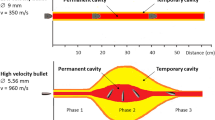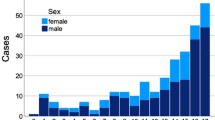Abstract
Purpose
Nerve injuries from missile and gunshot wounds often produce significant disability, and their management is controversial. The role of the surgeon in cases of missile wounds with neurologic deficits is not well defined. Enhancing the trauma team’s ability to recognize treatable nerve injuries will lead to improved outcomes. Further, raising awareness of the time-sensitive nature of these injuries will also improve results in these cases.
Methods
We reviewed a consecutive series of 17 pediatric patients with peripheral nerve injuries caused by missile and gunshot wounds in a tertiary care children’s hospital. We examined the indications for surgery, presence of associated injuries, mechanisms of injury, demographic characteristics and clinical outcomes.
Results
Urban victims were significantly more likely to have been intentionally assaulted than rural or suburban victims and they were also less likely to have completed follow-up care. High-energy weapons were more likely to require surgery compared with low-energy weapons. Patients presenting with tendon injuries were more likely to have a high-grade nerve injury requiring surgery.
Conclusions
Patients presenting with tendon lacerations or high-energy mechanisms were significantly more likely to require surgery. Early exploration should be undertaken in cases where transection is likely to have occurred. Early decompression of common entrapment sites distal to repairs or injuries should be performed. Because follow-up is poor in this population, treatment should be prompt and thorough.






Similar content being viewed by others
References
Stahl S, Rosenberg N (1999) Digital nerve repair by autogenous vein graft in high-velocity gunshot wounds. Mil Med 164(8):603–604
McGuigan R, Spinella PC, Beekley A, Sebesta J, Perkins J, Grathwohl K, Azarow K (2007) Pediatric trauma: experience of a combat support hospital in Iraq. J Pediatr Surg 42(1):207–210
Matos RI, Holcomb JB, Callahan C, Spinella PC (2008) Increased mortality rates of young children with traumatic injuries at a US army combat support hospital in Baghdad, Iraq, 2004. Pediatrics 122(5):e959–e966
Christoffel KK, Naureckas SM (1994) Firearm injuries in children and adolescents: epidemiology and preventive approaches. Curr Opin Pediatr 6(5):519–524
Scribano PV, Nance M, Reilly P, Sing RF, Selbst SM (1997) Pediatric nonpowder firearm injuries: outcomes in an urban pediatric setting. Pediatrics 100(4):E5
Walsh IR, Eberhart A, Knapp JF, Sharma V (1988) Pediatric gunshot wounds—powder and nonpowder weapons. Pediatr Emerg Care 4(4):279–283
Keller JE, Hindman JW, Kidd JN, Jackson RJ, Smith SD, Wagner CW (2004) Air-gun injuries: initial evaluation and resultant morbidity. Am Surg 70(6):484–490
Victoroff BN, Robertson WW Jr, Eichelberger MR, Wright C (1994) Extremity gunshot injuries treated in an urban children’s hospital. Pediatr Emerg Care 10(1):1–5
Stricker SJ, Volgas DA (1998) Extremity handgun injuries in children and adolescents. Orthopedics 21(10):1095–1110
Stucky W, Loder RT (1991) Extremity gunshot wounds in children. J Pediatr Orthop 11(1):64–71
Washington ER, Lee WA, Ross WA Jr (1995) Gunshot wounds to the extremities in children and adolescents. Orthop Clin North Am 26(1):19–28
Letts RM, Miller D (1976) Gunshot wounds of the extremities in children. J Trauma 16(10):807–811
Byrne A, Curran P (2006) Necessity breeds invention: a study of outpatient management of low velocity gunshot wounds. Emerg Med J 23(5):376–378
Author information
Authors and Affiliations
Corresponding author
Rights and permissions
About this article
Cite this article
Stoebner, A.A., Sachanandani, N.S. & Borschel, G.H. Upper and lower extremity nerve injuries in pediatric missile wounds: a selective approach to management. Pediatr Surg Int 27, 635–641 (2011). https://doi.org/10.1007/s00383-010-2734-y
Accepted:
Published:
Issue Date:
DOI: https://doi.org/10.1007/s00383-010-2734-y




